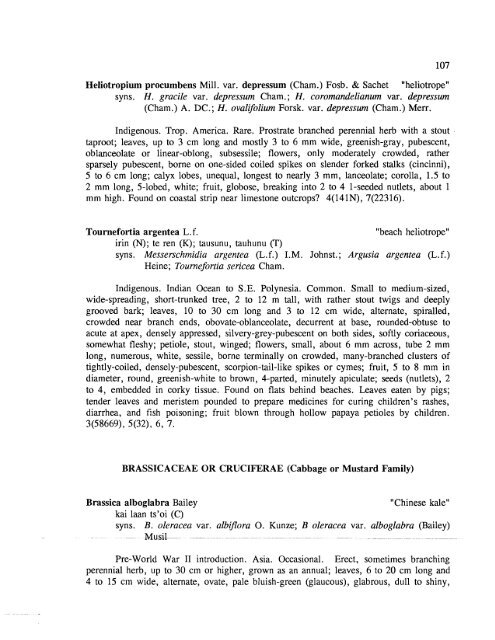atoll research bulletin no. 392 the flora of - Smithsonian Institution ...
atoll research bulletin no. 392 the flora of - Smithsonian Institution ...
atoll research bulletin no. 392 the flora of - Smithsonian Institution ...
Create successful ePaper yourself
Turn your PDF publications into a flip-book with our unique Google optimized e-Paper software.
Heliotropium procumbens Mill. var. depressum (Cham .) Fosb . & Sachet "heliotrope"<br />
syns. H. gracile var. depressum Cham. ; H. corornandelianurn var. depressurn<br />
(Cham.) A. DC.; H. ovalijolium Forsk. var. depressum (Cham.) Men.<br />
Indige<strong>no</strong>us. Trop. America. Rare. Prostrate branched perennial herb with a stout<br />
taproot; leaves, up to 3 cm long and mostly 3 to 6 mm wide, greenish-gray, pubescent,<br />
oblanceolate or linear-oblong, subsessile; flowers, only moderately crowded, ra<strong>the</strong>r<br />
sparsely pubescent, borne on one-sided coiled spikes on slender forked stalks (cincinni),<br />
5 to 6 cm long; calyx lobes, unequal, longest to nearly 3 mm, lanceolate; corolla, 1.5 to<br />
2 mm long, 5-lobed, white; fruit, globose, breaking into 2 to 4 1-seeded nutlets, about 1<br />
mm high. Found on coastal strip near limestone outcrops? 4(l4 1 N), 7(223 16).<br />
Tournefortia argentea L. f. "beach heliotrope"<br />
irin (N); te ren (K); tausunu, tauhunu (T)<br />
syns. Messerschmidiu argentea (L. f.) I. M. Johnst. ; Argusia argentea (L. f.)<br />
Heine; Tourncfortia sericea Cham.<br />
Indige<strong>no</strong>us. Indian Ocean to S.E. Polynesia. Common. Small to medium-sized,<br />
wide-spreading, short-trunked tree, 2 to 12 m tall, with ra<strong>the</strong>r stout twigs and deeply<br />
grooved bark; leaves, 10 to 30 cm long and 3 to 12 cm wide, alternate, spiralled,<br />
crowded near branch ends, obovate-oblanceolate, decurrent at base, rounded-obtuse to<br />
acute at apex, densely appressed, silvery-grey-pubescent on both sides, s<strong>of</strong>tly coriaceous,<br />
somewhat fleshy; petiole, stout, winged; flowers, small, about 6 mm across, tube 2 mm<br />
long, numerous, white, sessile, borne terminally on crowded, many-branched clusters <strong>of</strong><br />
tightly-coiled, densely-pubescent, scorpion-tail-like spikes or cymes; fruit, 5 to 8 mm in<br />
diameter, round, greenish-white to brown, 4-parted, minutely apiculate; seeds (nutlets), 2<br />
to 4, embedded in corky tissue. Found on flats behind beaches. Leaves eaten by pigs;<br />
tender leaves and ~neristem pounded to prepare medicines for curing children's rashes,<br />
diarrhea, and fish poisoning; fruit blown through hollow papaya petioles by children.<br />
3(58669), 5(32), 6, 7.<br />
BRASSICACEAE OR CRUCIFERAE (Cabbage or Mustard Family)<br />
Brassica alboglabra Bailey "Chinese kale"<br />
kai laan ts'oi (C)<br />
syns. B. olcracea var. albijlora 0. Kunze; B oleracca var. alboglabra (Bailey)<br />
-- Musil-<br />
-- - --- - - -- --- - - - -<br />
Pre-World War I1 introduction. Asia. Occasional. Erect, sometimes branching<br />
perennial herb, up to 30 cm or higher, grown as an annual; leaves, 6 to 20 cm long and<br />
4 to 15 cin wide, alternate, ovate, pale bluish-green (glaucous), glabrous, dull to shiny,

















